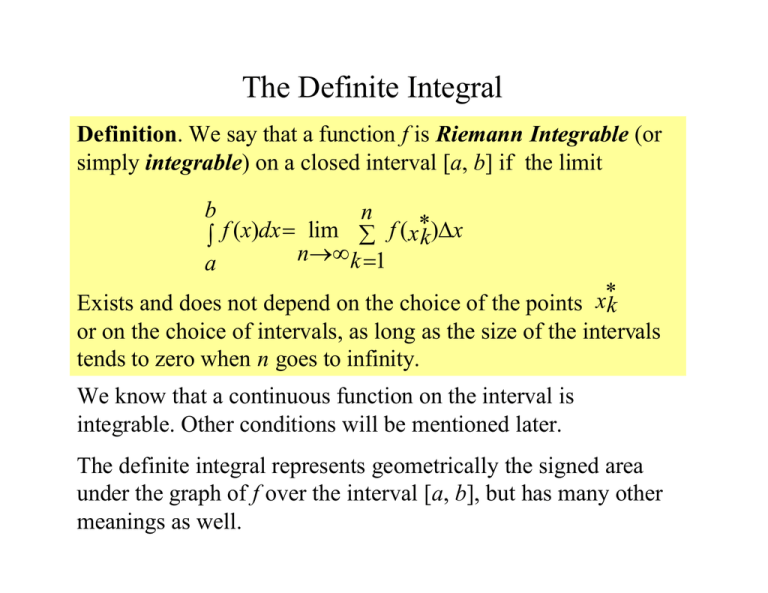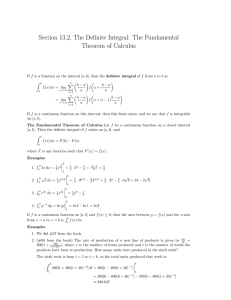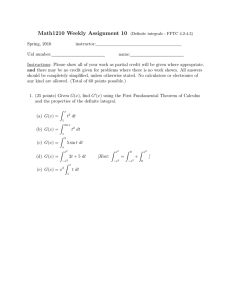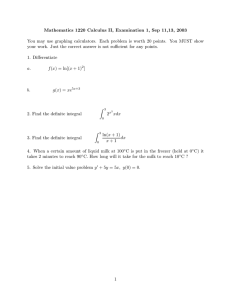The Definite Integral
advertisement

The Definite Integral Definition. We say that a function f is Riemann Integrable (or simply integrable) on a closed interval [a, b] if the limit b n *)∆x f ( x ) dx = lim f ( x ∑ k ∫ n→∞ k =1 a Exists and does not depend on the choice of the points x*k or on the choice of intervals, as long as the size of the intervals tends to zero when n goes to infinity. We know that a continuous function on the interval is integrable. Other conditions will be mentioned later. The definite integral represents geometrically the signed area under the graph of f over the interval [a, b], but has many other meanings as well. Problem. Sketch the region whose signed area is represented by π the definite integral 3 ∫ sin xdx −π 3 and evaluate the integral geometrically. Solution. A2 A1 π 3 ∫ sin xdx =− A1+ A2 = 0 −π 3 Problem. Sketch the region whose signed area is represented by the definite integral 2 2 dx 4 − x ∫ 0 and evaluate the integral geometrically. Solution. circle x2 + y2 = 4 2 2 dx = 1 4π =π 4 − x ∫ 4 0 ( ) semicircle y = 4− x2 If f(x) is a continuous function in an interval containing the points a and b, we have seen two different ideas with a very similar notation. f ( x ) dx ∫ The indefinite integral of f - this is the family of all antiderivatives of f on the interval. b f ( x ) dx ∫ a The definite integral of f - this is a number representing the signed area under f between a and b. The reason for using this remarkably similar notation for two ideas that seem completely different - one dating from the beginning of calculus in the 18th century, the other having origins in ancient Greece 2000 years before that - is that they are related. We only use that notation because we are aware of the fundamental theorem of calculus that ties the two ideas together. In a short while we will develop this theorem and show how it is used. When this is done, the notation we have chosen will turn out to be extremely useful and suggestive. Properties of the Definite Integral Definition. (a) If a is in the domain of f, we define a ∫ f (x)dx = 0 a (b) If f is integrable on [a, b] a b ∫ f (x)dx =− ∫ f (x)dx b a Example. 1 4 (a) ∫ x dx=0 1 1 3 (b) ∫ (1+ x ) dx =−∫ (1+ x ) dx 3 1 1 3 ∫ (1+ x) dx =−∫ (1+ x) dx =−6 3 1 Theorem. If f and g are integrable on [a, b] and if c is a constant, then cf, f + g, and f − g are integrable on [a, b] and b b (a) ∫ cf (x)dx = c ∫ f (x)dx a a b b b (b) ∫ [ f (x)+ g(x)]dx = ∫ f (x)dx+ ∫ g(x)dx a a a b b b (c) ∫ [ f (x)− g(x)]dx = ∫ f (x)dx− ∫ g(x)dx a a a Basically, these results are proved by noting that they are true for the approximating sums, then using properties of the limit. Part (b) can be extended to more than two functions. Then we have b b b b ∫ [ f1(x) + f2(x)+L+ f n(x)]dx = ∫ f1(x)dx+ ∫ f 2(x)dx+L+ ∫ f n(x)dx a a a a or, in sigma notation b n n b ∫ ∑ f k (x) dx = ∑ ∫ f k (x)dx k =1a ak =1 Some properties are motivated by the interpretation of integrals as areas or signed areas. Theorem. If f is integrable on a closed interval containing a, b, and c, then b c b ∫ f (x)dx = ∫ f (x)dx+ ∫ f (x)dx a a c Theorem. (a) If f is integrable on [a, b] and f(x) ≥ 0 for all x in [a, b], then b ∫ f (x)dx ≥ 0 a (b) If f and g are integrable on [a, b] and f(x) ≥ g(x) for all x in [a, b], then b b ∫ f (x)dx≥ ∫ g(x)dx a a Proof. Part (a) is geometrically obvious. For part (b), let h(x) = f(x) − g(x). Then f(x) ≥ g(x) is equivalent with h(x) ≥ 0 and b b b ∫ f (x)dx≥ ∫ g(x)dx is equivalent with ∫ h(x)dx ≥ 0 a a a The result follows by applying part (a) to h. Problem. Use the areas shown in the accompanying figure to find c c b d (a) ∫ f (x)dx (b) ∫ f (x)dx (c) ∫ f (x)dx (d) ∫ f (x)dx b a a a Solution. (a) 0.8 (b) − 2.6 (c) −2.6 + 0.8 = −1.8 (d) 0.8 −2.6 + 1.5 = 2.3 −2.6 = −0.3 Problem. In each part, evaluate the integral, given that 2x, x≤1 f (x) = 2, x >1 1 (a) ∫ f (x)dx 0 1 (b) ∫ f (x)dx −1 10 (c) ∫ f (x)dx 1 5 (d) ∫ f (x)dx 1 2 Solution. 1 1 10 1 (a) ∫ f (x)dx= (1×2) =1 (b) ∫ f (x)dx=0 (c) ∫ f (x)dx=9×2 =18 2 0 −1 1 5 1 5 (2+1) 1 (d) ∫ f (x)dx = ∫ f (x)dx+ ∫ f (x)dx = × + 4×2 =8 3 4 2 2 1 1 1 2 2 −2 ∫ f (x)dx 3 3 1 if ∫ f (x)dx= 2 and ∫ f (x)dx=−6 1 −2 Problem. Find 3 3 1 Solution. We know that ∫ f (x)dx = ∫ f (x)dx+ ∫ f (x)dx = 2−6 =−4 1 −2 −2 thus −2 ∫ f (x)dx = 4 3 Problem. Use appropriate theorems and formulas from geometry to evaluate the integrals 2 0 (b) ∫ [1+3| x|]dx (a) ∫ 2x+5 9− x2 dx −2 −3 Solution. (a) 0 0 0 0 0 2 2 2 dx 2 x + 5 9 − x dx = 2 xdx + 5 9 − x dx = 2 xdx + 5 9 − x ∫ ∫ ∫ ∫ ∫ −3 −3 −3 −3 −3 3×3=−9 2 2 1 9π 9π = 4 4 0 0 9 5π 2 9 π 2 ∫ dx+5 ∫ 9− x dx =2 +5× =91+ 2 4 4 −3 −3 2 2 2 (b) ∫ [1+3|x|]dx = ∫ 1dx+3 ∫ |xdx | = 4+3(2+2) =16 −2 −2 −2 Problem. Determine if the following integrals are positive or negative 2 x3 −9 −1 x4 (b) ∫ dx (a) ∫ dx |x |+1 3− x −2 −3 Solution. (a) 3− x is positive if x < 3, and x4 is always positive, so x4 is positive in the interval [−3, −1]. This means that 3− x −1 x4 dx is positive by a previous theorem. ∫ 3− x −3 (b) In the interval [−2, 2], the quantity x3−9 is always negative. while the expression | x|+1 is always positive. Thus x3 −9 is always negative in that interval. By a previous theorem | x|+1 2 x3 −9 ∫ |x|+1 dx is therefore negative. −2 Problem. Express the following limits as definite integrals over the interval [a, b]. Do not try to evaluate the integrals. n *3 (a) lim ∑ (xk) ∆x; a =1,b = 2 n →∞k =1 n (b) lim ∑ (sin 2 x*k)∆x; a =0,b =π 2 n →∞k =1 Solution. 2 3 (a) ∫ x dx 1 π 2 (b) ∫ sin2 xdx 0 Problem. Express the following limits as definite integrals over the interval [a, b], and evaluate using geometric methods. n lim ∑ ( 4−(x*k )2 ∆x; a =−2,b = 2 n →∞k =1 Solution. This limit is 2 2 dx 4 − x ∫ −2 Thus the integral is 2π.




